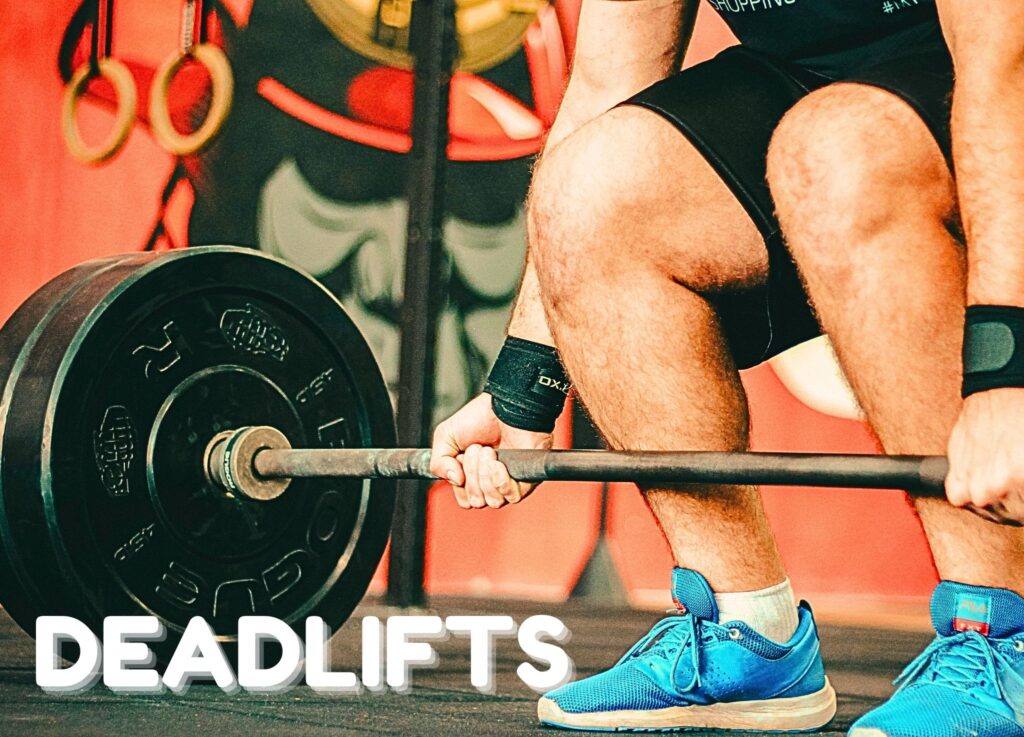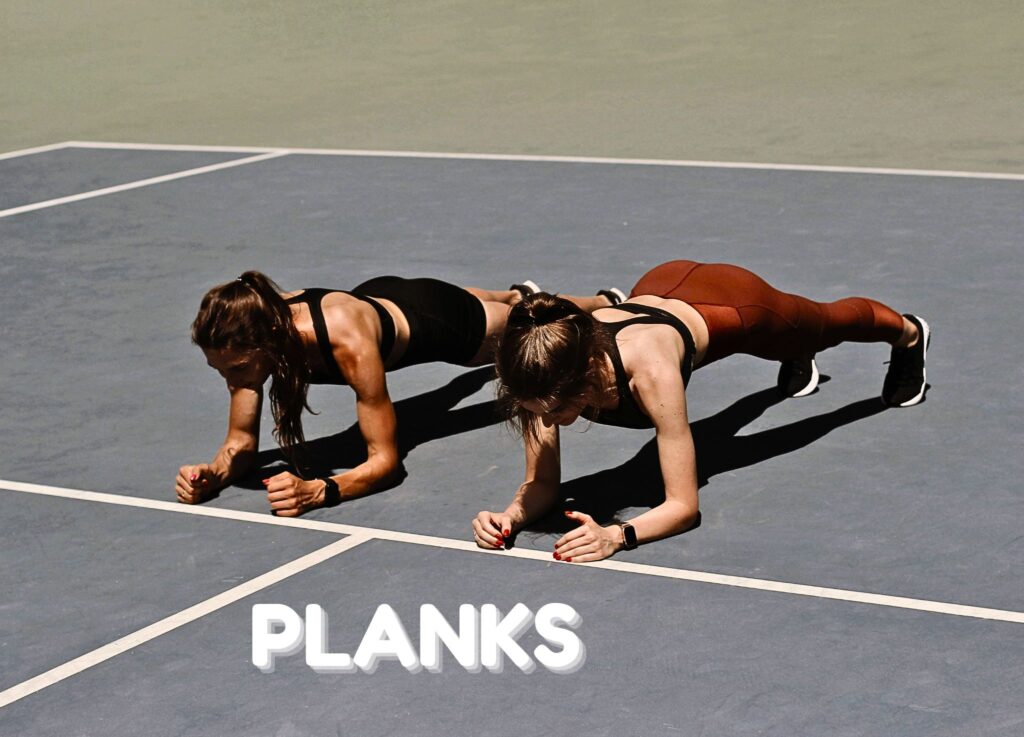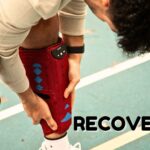Top 5 Functional Fitness Exercise along with Benefits

1. Squats
What Are Squats?
Squats are involve your lower body movements.
🔍 Muscles Worked
Quadriceps (front thighs), Gluteus maximus (buttocks), Hamstrings (back thighs), Calves, Lower back,Core muscles (stabilizers)
How to Perform a Bodyweight Squat
Step-by-Step Instructions
- Starting Position:
- Stand with feet shoulder-width apart.
- Toes slightly turned out (~15°).
- Movement:
- Engage your core.
- Keep your chest up and back straight.
- Return:
- Press through your heels to return to standing.
- Squeeze your glutes at the top.
🧠 Mind-Muscle Connection
Focus on engaging:
- Glutes when standing up.
- Core to keep your torso upright.
- Quads and hamstrings for controlled descent and ascent.
💪 Benefits of Squats
- 1. Build Lower Body Strength
- 2. Enhance Core Stability
- 3. Improve Mobility & Flexibility
- 4. Burn Calories & Boost Metabolism
- 5. Prevent Injury
- 6. Functional Fitness
🔁 Variations of Squats
| Variation | Description |
|---|
| Goblet Squat | Hold a dumbbell or kettlebell close to chest |
| Jump Squat | Add a jump at the top for power and cardio |
| Bulgarian Split Squat | One leg behind on a bench for single-leg focus |
| Sumo Squat | Wider stance; targets inner thighs |
| Barbell Back Squat | Heavy resistance for strength training |
2. Deadlifts

2. Deadlifts
🔍 Muscles Worked in a Deadlift
Primary Muscles
- Gluteus maximus (butt)
- Hamstrings
- Erector spinae (lower back)
- Quadriceps (front of thigh)
- Trapezius (upper back)
Secondary Muscles
- Forearms & grip muscles
- Core (abs & obliques)
- Lats (upper/mid-back)
How to Perform a Conventional Barbell Deadlift
Step-by-Step Instructions
- Starting Position:
- Bar should be over the midfoot.
- Lift:
- Take a deep breath and brace your core.
- Drive through your heels to lift the bar.
- Extend hips and knees at the same rate.
- Lower (Eccentric Phase):
- Push hips back first, then bend knees.
- Reset for the next rep.
⚠️ Key Form Tips
- Maintain a neutral spine (avoid rounding your back).
- Engage your lats to keep the bar close.
- Keep the weight evenly distributed across your feet.
- Always brace your core before lifting.
💪 Benefits of Deadlifts
- 1. Total Body Strength
- 2. Improves Posterior Chain
- 3. Enhances Grip Strength
- 4. Boosts Core Stability
- 5. Increases Hormonal Output
- 6. Functional Movement
- 7. Improves Bone Density
🔁 Deadlift Variations
| Variation | Benefits |
|---|
| Sumo Deadlift | Wider stance; more quad and inner thigh involvement; less strain on lower back |
| Romanian Deadlift (RDL) | Focuses on glutes and hamstrings with a straighter leg position |
| Trap Bar Deadlift | Easier on the spine; more upright torso—great for beginners |
| Deficit Deadlift | Performed from a raised platform; increases range of motion and strength off the floor |
| Snatch-Grip Deadlift | Wide grip; emphasizes upper back and traps more |
| Single-Leg Deadlift | Improves balance, stability, and glute activation |
🧠 Common Mistakes to Avoid
- Rounding the lower back
- Letting the bar drift away from the body
- Hyperextending the back at the top
- Pulling with arms instead of legs and hips
- Not bracing the core before the lift
🎯 Tips for Beginners
- Master the hip hinge before loading the bar.
3. Lunges

3. LUNGES
🔍 Muscles Worked in a Lunge
Primary Muscles
- Quadriceps (front thighs)
- Gluteus maximus (buttocks)
- Hamstrings (back of thighs)
- Adductors (inner thighs)
Secondary Muscles
- Calves
- Core muscles (obliques and abs)
- Hip stabilizers (glute medius/minimus)
How to Perform a Basic Forward Lunge
Step-by-Step Instructions
- Starting Position:
- Stand tall with feet hip-width apart.
- Step Forward:
- Take a big step forward with one leg.
- Lower Your Body:
- Bend both knees to ~90° angles.
- Push Back:
- Repeat on the opposite leg.
⚠️ Form Tips
- Keep your torso upright and chest lifted.
- Avoid leaning forward or arching your back.
- Engage your core to maintain stability.
💪 Benefits of Lunges
- 1. Builds Unilateral Strength
- 2. Enhances Balance and Coordination
- 3. Boosts Core Engagement
- 4. Improves Hip Mobility
🔁 Lunge Variations
| Variation | Description |
|---|
| Walking Lunge | Step forward continuously, alternating legs with each step |
| Reverse Lunge | Step backward instead of forward—easier on knees |
| Lateral Lunge | Step sideways; targets inner thighs and hips |
| Curtsy Lunge | Step one leg diagonally behind the other; targets glute medius and inner thighs |
| Elevated Lunge (Bulgarian Split Squat) | Back foot rests on a bench; great for glutes and quads |
| Jump Lunge | Explosive jumping between lunge positions; builds power and cardio |
🧠 Common Mistakes to Avoid
- Letting the front knee collapse inward
- Stepping too short or too far forward
- Letting the heel of the front foot rise
- Rushing the movement—control is key
- Leaning the torso too far forward
🧠 Beginner Tips
- Focus on quality reps, not quantity.
4. Push-Ups

4. PUSH-Ups
🔍 Muscles Worked in a Push-Up
Primary Muscles
- Pectoralis major (chest)
- Triceps brachii (back of the arms)
- Anterior deltoids (front shoulders)
Secondary Muscles
- Core (abs and obliques)
- Serratus anterior (side of ribs)
- Lower back (erector spinae)
- Glutes and quads (for stability)
🧭 How to Perform a Standard Push-Up
▶️ Step-by-Step Instructions
- Start Position:
- Begin in a plank position.
- Hands slightly wider than shoulder-width.
- Feet together or hip-width apart.
- Lowering Phase:
- Engage your core and glutes.
- Keep elbows at about a 45° angle (not flared out wide).
- Lower until chest is just above the floor.
- Push Phase:
⚠️ Form Tips
- Neck neutral (don’t crane your head).
- Don’t let your lower back sag—engage your abs.
- Elbows should be close to body to avoid injury
- Lower chest, not just your head.
💪 Benefits of Push-Ups
- 1. Builds Upper Body Strength
- 2. Strengthens Core and Stability
- 3. Improves Functional Movement
- 4. Enhances Joint Support
- 5. Boosts Endurance and Cardio
- 6. No Equipment Required
- 7. Scalable to All Fitness Levels
🔁 Push-Up Variations
| Level | Variation | Focus |
|---|
| 🟢 Beginner | Wall Push-Up | Builds base strength |
| 🟢 Beginner | Knee Push-Up | Less load on upper body |
| 🟡 Intermediate | Incline Push-Up | Easiest full-body version (hands elevated) |
| 🟡 Intermediate | Standard Push-Up | Full-body control and strength |
| 🟡 Intermediate | Decline Push-Up | Targets upper chest and shoulders |
| 🔴 Advanced | Diamond Push-Up | Intense triceps and inner chest focus |
| 🔴 Advanced | Archer Push-Up | Builds unilateral strength |
| 🔴 Advanced | Clap Push-Up | Adds explosive power |
| 🔴 Advanced | One-Arm Push-Up | Extreme core and upper body challenge |
🔁 Push-Up Progression Plan Example:
| Week | Variation | Sets × Reps |
|---|
| 1–2 | Incline Push-Up | 3 × 10 |
| 3–4 | Knee Push-Up | 3 × 10–15 |
| 5–6 | Standard Push-Up | 3 × 8 |
| 7+ | Add Tempo or Elevation | 3–4 × 10–12 |
5. Planks

5. Planks
🔍 Muscles Worked in a Plank
Primary Muscles
- Rectus abdominis (6-pack abs)
- Transverse abdominis (deep core stabilizer)
- Obliques (sides of the core)
- Erector spinae (lower back)
Secondary Muscles
- Shoulders
- Chest
- Glutes
- Quads
🧭 How to Perform a Forearm Plank (Standard Version)
▶️ Step-by-Step Instructions
- Starting Position:
- Place forearms on the ground with elbows directly under shoulders.
- Body Alignment:
- Your body should form a straight line from head to heels.
- Keep your neck neutral and look down at the floor.
- Hold the Position:
- Breathe steadily.
- Squeeze your glutes and thighs.
- Avoid letting hips drop or rise too high.
- Duration:
- Beginners: Start with 15–30 seconds.
- Intermediate: 30–60 seconds.
- Advanced: 1–2 minutes or longer (with perfect form).
💪 Benefits of Planks
- 1. Builds Deep Core Strength
- 2. Improves Posture
- 3. Enhances Balance & Coordination
- 4. Reduces Risk of Injury
- 5. Boosts Athletic Performance
- 6. Improves Flexibility (Indirectly)
🔁 Plank Variations
| Variation | Description | Focus |
|---|
| High Plank (Straight-Arm) | Hands under shoulders like a push-up | More shoulder/chest activation |
| Side Plank | One arm/leg on the side | Obliques, glute medius |
| Plank with Leg Lift | Lift one leg slightly | Glutes, balance |
| Plank with Shoulder Tap | Tap shoulders alternately | Anti-rotation core strength |
| Plank to Push-Up | Transition between low and high | Dynamic stability |
| Weighted Plank | Add plate to back | Increased resistance |
🧠 Common Mistakes to Avoid
- Sagging hips – puts pressure on lower back
- Butt too high – reduces core engagement
- Looking forward – strains neck
- Holding breath – reduces oxygen supply to muscles
- Collapsing shoulders – causes poor support
🎯 Beginner Progression Plan
| Week | Hold Time | Sets |
|---|
| 1 | 20 sec | 3 |
| 2 | 30 sec | 3 |
| 3 | 45 sec | 3 |
| 4 | 60 sec | 3 |






